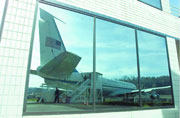IF UP UNTIL LAST week it seemed inconceivable that Boeing would move its headquarters out of Seattle, that’s because we were thinking of a Boeing that no longer exists. Underneath our very noses and without many of us realizing it, Boeing has in a remarkably short five years made itself into a very different company than the one long intertwined with the region’s economy, history, and social fabric. Even with its headquarters here, Boeing wasn’t really a Seattle company anymore, nor exclusively a maker of planes—and the company, with last week’s shock announcement, wants to drive that message home.
As Boeing Chair Phil Condit outlined in a Washington, D.C., press conference, the “fundamental transformation” of the company, as he called it, was instigated by a series of mergers and acquisitions that began in the mid-’90s. Most important of those was the 1997 merger with McDonnell Douglas Corp., which gave Boeing a huge workforce in St. Louis and elsewhere. Now Boeing maintains major manufacturing centers in St. Louis and Southern California as well as the Puget Sound area. It also has smaller facilities scattered across the country and partners around the world. Less than half of the company’s 199,000 employees now work around Puget Sound.
The mergers and acquisitions gave Boeing not only new workers in new locales but also new production areas beyond commercial planes, namely military aircraft (an area the company once pioneered but has since neglected) and space technology. At the same time, Boeing has been open about the fact that the mature aspects of all its businesses don’t have a lot of room for financial growth—only a 5 percent potential, according to Condit at the press conference; the company has looked for new higher-growth businesses, both within the aerospace industry and outside it. For instance, a couple of weeks ago, in a high-tech venture most people would never associate with Boeing, the company used a Hollywood premiere as an occasion to demonstrate a new system for delivering movies to theaters via satellites and fiber optics.
BY MOVING ITS HEADQUARTERS away from Seattle and its commercial airplane operation, Boeing is trying to signal its metamorphosis into a global, diverse company. It may seem odd that Boeing deliberately doesn’t want its headquarters to be in the same city as any of its production facilities; as Craig Buckham, president of Boeing’s engineers’ union, says, “They’re not moving to anyplace else; they’re simply moving away from one of their most commercially successful enterprises.” But Boeing is following a model that has proved successful for General Electric, another conglomerate that has its headquarters in a neutral location away from its many businesses.
While Seattle is losing as many as 1,000 corporate jobs, there is one consolation for the region. At the same time that Boeing announced its headquarters move, it revealed that it was giving a charged-up status to three business units, which from now on are to operate autonomously. The business unit dedicated to commercial aircraft will be based in Seattle. So the old familiar part of Boeing is staying put.
Or is it? “Our suspicion is that this is just the beginning,” says Buckham of the engineers’ union. If the company is willing to move its headquarters, he and others fear it will be willing to move some or all of the roughly 80,000 manufacturing jobs based in the region. The company has already moved some jobs to other parts of the country and abroad. Recently, it disclosed it might outsource the construction of wings on the 747X to Japan. Last week it transferred 500 manufacturing jobs for the 757 jetliner to Kansas.
The fear of further job loss is heightened by the fact that Boeing’s values have changed along with everything else. “It used to be the company wanted to be the best plane maker in the world,” says aerospace analyst Paul Nisbet of JSA Research in Rhode Island. “Now it wants to be the most profitable business.”
More than that, Boeing wants to please Wall Street above all else. Condit emphasized the point at last week’s press conference by endlessly repeating the phrase “shareholder value.” Most ominously for the future of jobs here, he talked about the “ability to move capital and talent to opportunities that maximize shareholder value.”
It was clearly another signal: The new Boeing will be as ruthless as it needs to be. And the old Boeing, no matter how many Puget Sound jobs ultimately stay or go, is dead.
For more on the Boeing departure, read Bombs away.








